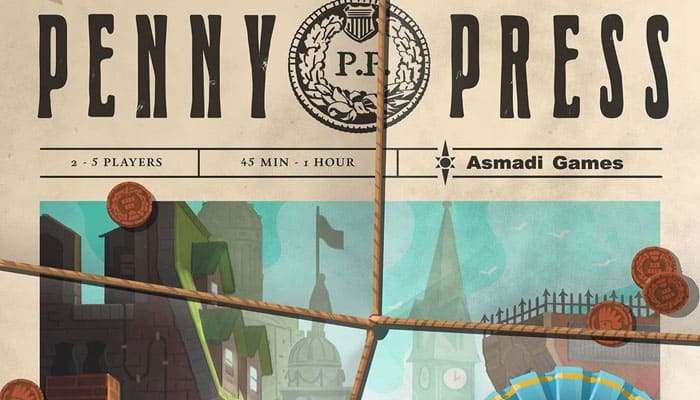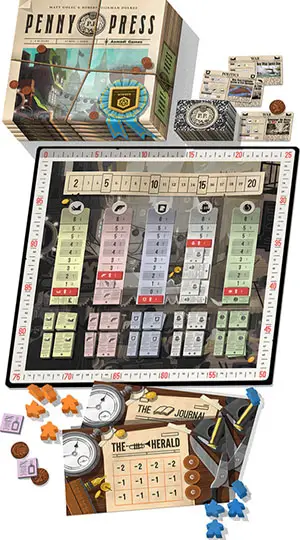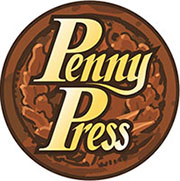
Set during the tumultuous 'yellow journalism' years at the end of the 19th century, Penny Press has players taking on the roles of newspaper barons such as Pulitzer and Hearst as they strive to become the dominant paper in old New York City.
Players compete for readers by sending out reporters to cover stories, and then by publishing those stories on the front page of their newspapers.
The newsworthiness of a story can change depending on how many stories are available and how many reporters are chasing those stories, so timing when to go to press is critical.

Components
- 1 game board
- 45 headline cards
- 5 player aid cards
- 5 newspaper player mats, 1 for each player color
- 25 reporters, 5 for each player color
- 5 scoring discs, 1 for each player color
- 1 newsboy token
- 60 stories in 4 shapes and 5 news beat colors
- 6 advertisements in purple
- 5 bonus markers, one for each news beat
- 5 arrow markers, one for each news beat
- 15 pennies
- Rule book
Object of the Game
Bonuses are awarded at the end of the game for the players who best cover the five leading news beats, or categories, of the day: War, Crime & Calamity, New York City, Politics, and the Human Condition.
The player with the most points at the end of the game, as measured on the circulation track, is the winner!
Setup


-
Place each player's scoring disc at 0, at the start of the circulation track.
-
Place the five bonus markers on 2, at the start of the bonus track. They will move in step 6.
-
Give each player a newspaper player mat and five matching reporters.
-
Place the pennies and advertisements next to the board.

-
Stack the stories and place them below their matching news beats. 3-star on the bottom, 2-star in the middle, and1-star on top.

-
Draw the initial headline cards, one for each player. For each card, advance the bonus marker as shown. Then place the stories shown on the card into their respective news beats.
For setup, ignore the advertisement.

-
Place the arrow markers just above the stories in each news beat.
-
Choose a start player. We recommend the player who has last read a real newspaper.
Now you can begin!
Game Play
On your turn, you must perform one of the four actions below. You may not pass your turn to do nothing.
After performing one of the four actions, check to see if any of the arrow markers on the news beats (the five categories of news, represented by columns on the board) need to be moved up or down.
This is called adjusting the news beats. After adjusting the news beats, play passes clockwise to the next player.
This continues until someone triggers the final edition phase of the game.
Assign Reporters
Place one or more of your reporters from your player mat onto one story in any of the news beats.
Reporters may be assigned to a story that already has other reporters assigned to it, whether yours and/or another player's, and there is no limit on how many reporters can be assigned to a single story.
Recall Reporters
Remove any number of your reporters from the board and place them back on your player mat. Sometimes this is the best available choice if some of your plans have not panned out!
Reassign a Reporter Move one of your reporters from one story to any other story. You may only move one reporter. As with the 'assign' action, a reporter may be reassigned to a story that already has other reporters present, and there is no maximum number of reporters per story.

Go to Press
When you decide to go to press, you will get to claim the stories you've sent your reporters out to cover, and most importantly, score points on the circulation track.
When you choose to Go to Press as your action, do the following steps in order:
-
Claim Stories: Pick up all the stories where you have at least as many reporters as any other player.
If another player has more reporters than you on a story, leave that story on the board, along with all reporters on that story-including yours. You must pick up all the stories you can claim.
-
Award Scoop Points: Each player with at least one reporter on a story you picked up receives scoop points (they still got a piece of the story, but you scooped them by getting it to press first).
The scoop value of a news beat is the value pointed to by the smaller, S-shaped arrow on the arrow marker.
Players only score once for each scooped story, even if they had more than one reporter assigned to that story, but they may be scooped-and score-from multiple stories.
Return all reporters from all stories that you picked up to their owners' player mats.
-
Build Your Front Page: Build and score your front page by taking the stories you claimed and laying them out on the grid on your player mat, following the rules under 'Building and Scoring a Front Page'.
After scoring, clear your front page of all stories and also remove your advertisement, if you have one.
Your published stories stay face up next to your player mat, with their stars clearly visible to all other players, for the remainder of the game.
-
Take a Penny: Take a penny, and put it in the lowest open spot on your player mat.
-
Draw a New Headline Card: Draw a headline card (see 'Drawing Headline Cards'). This will add new stories to the board, advance a bonus marker, and place an advertisement on your front page.
Important: You may not go to press if you can't claim at least one story.
Final Edition

The end of the game, or final edition, is triggered when one player goes to press for the third time (in a 4- or 5-player game) or fourth time (in a 2- or 3-player game).
Pennies on the player mats help keep track of how many times everyone has gone to press and should be visible to all players.
As soon as the final edition is triggered, flip the arrow markers over to their red sides to show that they should no longer move (but keep them pointing to the same value!).
The player who triggered the final edition goes to press as normal, but does not draw a headline card. This player is now done and will not have another turn. However, each remaining player will still have a chance to claim one last story and/or go to press.
In turn order, each remaining player may take a turn as normal, with the exception that they may assign or recall only one reporter (players may also choose to reassign one reporter or go to press, per usual).
Do not adjust the news beats! Most players will take this opportunity to improve their position on the board, but there may be an advantage to going to press right away. Players who go to press are done and will not have another turn.
Then-again in turn order-any remaining players may go to press. Stories are claimed, front pages are scored, scoop points are awarded (even to players who have already published their final edition), but NO headline cards are drawn!
Finally, all that remains is to see which player's newspaper best covered the five leading news beats of the day
Drawing Headline Cards
Headline cards reveal the news being reported on in turn-of-the-century New York City. Each card falls into one of the five news beats, as listed at the top of the card. The news beat will determine which bonus marker is moved, and a story from that news beat will always come out onto the board.

When you draw a headline card, immediately do the following steps in order:
-
Share the News
Read the new headline out loud. We're in the news business, after all!
-
Advance Bonus Marker
Move the bonus marker matching the headline card's news beat up by 1, 2, or
3 spaces, as indicated in the arrow. The first space on the bonus track is a 2, not a 0, so if the first headline card has a bonus value of +3, the marker should go to 5, not 3!
-
Add Stories to News Beats
Take the stories shown on the headline card from the story supply stacks. You can use the letters on the stories to help identify the right shapes.
Place these stories in the news beats on the board, either directly above another story or, if the news beat is empty, on the 'X' space.
Stories are always taken from the top of the supply stack, in order of star value.
Stories are always placed in the news beat of the same color.
Stories are always placed sideways, turned 90° from how they are depicted on the headline card, covering the least amount of spaces possible on the news beat.
There shouldn't be any spaces between stories in the news beat, and the bottom story should always cover the 'X' space. Slide stories down in the news beat as needed.
The individual position of the stories in the news beat does not matter, only the height of the news beat column is important.If a headline card calls for a story piece from an empty stack, then no story is placed.
If the news beat doesn't have enough empty spaces to fit the story, then don't place that story-just leave it on its stack. In the rare event that this happens during setup, leave the 3-star C or D story on the stack, and place the other stories.
-
Advertisement
Place an advertisement on your front page in the highlighted column, in the row of your highest penny. You should never have more than one advertisement.This step is skipped during setup, as a player's first newspaper does not have an advertisement.
After resolving the four steps on the headline card it is discarded to a face up pile next to the deck. Remember, during the final edition, do NOT draw headline cards!
Adjusting News Beats
Adjusting the news beats keeps the arrow markers pointing at the correct values for publishing stories and being scooped in each news beat.
Because emerging stories could generate interest in a particular news beat, and because newspapers of the day weren't above stirring up a story they were reporting on to sell papers, news beats will often need adjusting after reporters or stories have been added or removed.
Players should adjust the news beats as necessary in between turns, but not during turns (as this may interfere with scoring) and never during the final edition phase of the game.
Tip: Have the next player in turn order adjust the news beats to keep turns moving along.
To adjust a news beat:
-
Make sure that all stories are turned sideways, covering the least amount of spaces on the news beat. The smaller two types of stories (A and B) should take up one space and the two larger types (C and D) should take up two spaces. No story should ever take up three spaces!
-
Then, make sure that the lowest story in every news beat sits on the 'X' space and that there are no empty spaces in between stories. Push stories down as needed. Stories should not overlap each other.
-
Finally, move the arrow markers so that for each news beat the number of spaces between the stories and the arrow marker equals the number of covered stories - those with at least one reporter on them.
The large central arrow on the arrow marker now points to the value of the news beat, while the smaller, S-shaped arrow points to the scoop value of the beat. The arrow markers can never be pushed above their maximum value of 6, regardless of placement of additional reporters.
Exception: During the final edition phase of the game, do NOT move the arrow markers! Since they are flipped over during the final edition, the red arrow markers should help players remember this.

In this example, the Crime and Calamity news beat (pink) has one covered story, and Politics (blue) has two, so the arrow markers are one, and two spaces away from the stories, respectively.
It doesn't matter that one Crime and Calamity story is covered by two different players, just that there are any reporters on it. The central arrows point to the news beat values: 3, and 4.
End of the Game
Moving from left to right on the bonus track, players tally up the stars on the stories they published in each news beat during the entire game.
The player with the highest number of stars in each news beat is awarded that beat's bonus points, as shown by the marker on the bonus track. In case of ties, all tied players receive the full amount of bonus points.
The player highest on the circulation track after bonus scoring is the most successful news baron and wins the game!
In the case of an overall tie, the tied player with the most stories wins. If there is still a tie, the victory is shared. If you really, really don't like ties, flip a penny to determine the winner.

At the end of the game, The Times, The Herald, and The World have all published Politics stories, and the bonus marker for Politics is at 7.
We compare the total number of stars. Even though The Herald has published three stories to The Times' one, both have a total of three stars.
Therefore, each receives the full 7 bonus points on the circulation track. The World does not receive any points.
Alternate Rules
Penny Press for Two Players
The 2-player game plays by the same rules as the 3-player game (final edition is triggered when a player publishes their fourth newspaper) with one change.
When playing with two, the first player takes their first turn as normal, and then the second player takes two turns, one right after the other. Play continues with each player taking two turns until final edition is triggered.
When a player triggers the final edition, the other player gets to assign/reassign/recall a single reporter and/or go to press with their final edition, just as in a 3-5 player game.
The Newsboy Strike Variant
This variant is for 4-5 advanced players who have played Penny Press several times. The newsboy strike variant should not be used with 2-3 players.
Added setup: Give the newsboy token to the second player (the player to the left of the first player).
When a player holds the newsboy, the newsboy strike has crippled their newspaper distribution. This player foregoes their normal action and instead passes the newsboy to the player to their right-counter- clockwise, in the opposite direction of turn order. Play then passes to the player to their left, per usual.
As soon as a player triggers the final edition, the newsboy strike is immediately settled and the newsboy is set aside for the remainder of the game.
Continue Reading
